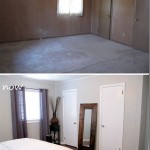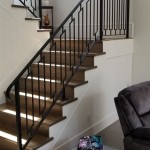Average Cost of Painting the Interior of a 3-Bedroom House
Painting the interior of a 3-bedroom house is a common home improvement project that can significantly enhance the aesthetic appeal and overall value of the property. However, understanding the associated costs is crucial for budgeting and planning purposes. The total expenditure can vary depending on a multitude of factors, including the size of the house, the quality of paint used, the condition of the walls, the complexity of the job, and whether the homeowner opts for a professional painting service or undertakes the project themselves.
This article aims to provide a comprehensive overview of the average cost of painting the interior of a 3-bedroom house, dissecting the various cost components and offering insights into how to optimize the budget. The focus will be on presenting factual information and data to help homeowners make informed decisions regarding their painting project.
Key Factors Influencing the Cost
Several key factors contribute to the overall cost of painting the interior of a 3-bedroom house. A thorough understanding of these factors is essential for accurate cost estimation.
Size and Layout: The square footage of the house is a primary determinant of the amount of paint required and the labor hours involved. A larger house will naturally require more paint and take longer to paint than a smaller one. The layout of the house, including the number of rooms, hallways, and architectural features, can also impact the cost. For example, houses with high ceilings, intricate trim, or numerous windows and doors will require more time and effort to paint, thus increasing the labor costs.
Paint Quality and Type: The quality of the paint directly affects the final appearance and durability of the paint job. Higher-quality paints generally offer better coverage, are more resistant to wear and tear, and have a longer lifespan. Different types of paint, such as latex, acrylic, and oil-based paints, also have varying costs. Latex and acrylic paints are commonly used for interior walls due to their ease of application, low odor, and water-based cleanup. Oil-based paints, while more durable, are less commonly used due to their higher cost, stronger odor, and more complex cleanup requirements. The chosen paint finish (matte, eggshell, satin, semi-gloss, and gloss) can also influence the price, with higher-sheen finishes generally being more expensive.
Wall Condition and Preparation: The condition of the walls plays a significant role in the amount of preparation work required before painting. Walls with cracks, holes, or peeling paint will need to be repaired and primed, which adds to the overall cost. Extensive repairs, such as patching large holes or repairing drywall damage, can significantly increase the labor hours and material costs. Proper preparation, including cleaning, sanding, and priming, is crucial for ensuring a smooth and long-lasting paint job. If the existing wall color is significantly darker or brighter than the desired new color, multiple coats of primer may be necessary to achieve optimal coverage, further increasing the material costs.
Labor Costs (DIY vs. Professional): The decision to hire professional painters or undertake the project oneself significantly impacts the overall cost. While DIY painting can save on labor costs, it requires time, skill, and the necessary tools and equipment. If the homeowner lacks experience or is uncomfortable with painting, hiring professional painters is generally recommended to ensure a quality finish. Professional painters typically charge by the hour or by the square foot, and their rates can vary depending on their experience, location, and the complexity of the job. Labor costs can account for a significant portion of the total cost, especially for larger houses or projects that require extensive preparation work.
Location: The cost of painting services and materials can vary significantly depending on the geographic location. Areas with a higher cost of living typically have higher labor rates and material prices. Urban areas may have higher costs compared to rural areas due to increased competition and demand for painting services. It is advisable to obtain quotes from multiple painting contractors in the local area to get a sense of the prevailing market rates.
Estimating the Cost: DIY vs. Professional
Estimating the cost of painting a 3-bedroom house requires considering both material costs and labor costs. The approach to estimation differs significantly depending on whether the homeowner chooses to DIY or hire professional painters.
DIY Painting Cost Estimation: For a DIY project, the primary costs are the materials, including paint, primer, brushes, rollers, tape, drop cloths, and other painting supplies. To estimate the amount of paint needed, the total surface area of the walls and ceilings needs to be calculated. This can be done by measuring the length and height of each wall and multiplying them to get the area. The areas of windows and doors should be subtracted from the total wall area. The total surface area is then divided by the paint's coverage rate (typically listed on the paint can) to determine the number of gallons of paint required. It is generally advisable to buy slightly more paint than estimated to account for spills, touch-ups, and potential extra coats. In addition to paint, the cost of other materials, such as brushes, rollers, tape, and drop cloths, should be factored in. The cost of these materials can range from a few dollars to several hundred dollars, depending on the quality and quantity purchased.
Professional Painting Cost Estimation: Estimating the cost of hiring professional painters typically involves obtaining quotes from multiple contractors. Painters usually provide estimates based on the square footage of the house, the number of rooms, and the complexity of the job. Some painters may charge by the hour, while others may charge a fixed price for the entire project. When obtaining quotes, it is important to ask for a detailed breakdown of the costs, including the cost of materials, labor, and any additional services, such as wall repairs or trim painting. It is also advisable to ask about the type and quality of paint that will be used. Comparing multiple quotes can help homeowners identify the most competitive and reliable contractor. The labor cost typically includes preparation, priming, painting, and cleanup. It's worth noting that some contractors might charge extra for moving furniture or removing wallpaper.
Average Price Ranges: While the exact cost can vary, general price ranges can provide a useful starting point. For a DIY project, the cost of materials for painting the interior of a 3-bedroom house typically ranges from $300 to $800, depending on the quality and quantity of paint and other materials. For a professional painting job, the cost can range from $2,000 to $6,000 or more, depending on the size of the house, the complexity of the job, and the contractor's rates. These are average ranges, and the actual cost may be higher or lower depending on the specific circumstances.
Cost-Saving Strategies
Homeowners can employ several strategies to reduce the cost of painting the interior of a 3-bedroom house without compromising on the quality of the final result.
Preparation is Key: Thorough preparation can significantly reduce the amount of time and effort required for painting, thus lowering labor costs (if hiring professionals) or saving time (if DIY). Filling cracks, patching holes, sanding rough surfaces, and cleaning the walls before painting can ensure a smooth and even finish, reducing the need for multiple coats of paint. If undertaking a DIY project, taking the time to properly prepare the surfaces can also minimize errors and rework.
Choose Paint Wisely: Selecting the right type and quality of paint can also impact the overall cost. While higher-quality paints may be more expensive upfront, they often offer better coverage and durability, potentially reducing the need for multiple coats and extending the lifespan of the paint job. Buying paint during sales or discounts can also help save money.
Negotiate with Contractors: When hiring professional painters, it is important to obtain multiple quotes and negotiate the price. Don't be afraid to ask for discounts or explore different options, such as providing the paint yourself. Clear communication with the contractor is essential to ensure that they understand your expectations and budget.
DIY Certain Tasks: Even if hiring professional painters, homeowners can consider handling some of the preparation work themselves, such as moving furniture, removing wall decorations, and cleaning the walls. This can reduce the labor costs and overall project cost. However, it is important to ensure that the preparation work is done properly to avoid negatively impacting the quality of the paint job.
Paint One Room at a Time: Rather than painting the entire house at once, consider painting one room at a time. This allows for better management of the budget and timeline. It also makes the project less overwhelming and provides an opportunity to learn and improve painting skills before tackling larger areas.

Cost To Paint A House Whole Painting Fixr

Cost Of Painting A House Interior Comprehensive Guide

How Much Does It Cost To Paint The Interior Of A House In Paintrite Pros

How Much Does It Cost To Paint The Interior Of A House In Paintrite Pros

How Much Does Interior House Painting Cost A New Leaf

The Cost Of Painting A House In 2024

How Much Does Interior Painting Cost Castle Complements

How Much Does Interior House Painting Cost In 2024 Forbes Home

How Much Does It Cost To Paint The Interior Of A House Angi

Average Cost To Paint A House Coloradopainting Com
Related Posts








